Dorchester's Treasures
The little town of Dorchester, some 115 miles south-west of London, is not the first place that springs to mind when considering matters archaeological, which just shows how wrong one can be, for the place is a miniature treasure trove and well worth a visit.
Literatii will, of course, know it as the birthplace of Thomas Hardy, whose series of depressing novels have become famous - these days chiefly through their television adaptations. Tess of the d'Urbervilles or the Mayor of Casterbridge have all featured at one time or another on school reading lists and have done much to deepen the gloom of generations of English students. The great man is appropriately commemorated by a statue depicting him surrounded by smiling children. One can only assume that he is reading to them from Hans Christian Anderson and not from his own works.
For historians and archaeologists, however, Dorchester is most famous for something that isn't in it. About three miles south of the town there is an isolated ridge and 600 years before Christ the local people took it into their heads to fortify the summit with an impressive earthen bank. As this involved hacking down into the chalk that lies a few inches below the surface in this part of the world, and as iron tools were still a rareity in the emerging Iron Age - the precious metal was reserved for more pratical purposes such as weapons for killing each other - the amount of work involved was stupendous.
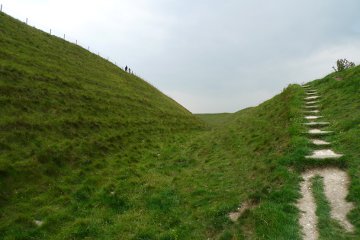
| |
| The scale of these earth banks can be seen from the two people walking along the top of the innermost bank while I am standing in the ditch below it. |
However having started on a good thing, the inhabitants of this hilltop fortress did not rest on their laurels but added a second and then a third ring to their defences - and in some places there is a fourth bank. Today we see these banks and ditches as indentations in the unbroken green of the hillside, but when they were first made they must have been an impressive sight - the dark green hill encircled by walls of gleaming white!
Unlike any other hillfort of which I know, Maiden Castle (to give it its modern name) had double-entrances at either end of the ridge. At each end the ramparts were pierced by two gateways, approached by two pathways, some 50' apart. No one knows why they did this; was it to keep men and women separate? or men and animals? Was it to provide one entrance for the nobles and another for the hoi polloi? Or was the daily traffic in and out so huge that a single entrance was not sufficient?
Personally I incline to the latter explanation, for Maiden Castle is possibly the largest hill fort in the world - it is certainly the largest in Britain. The ramparts enclose an area of 50 acres, but even more telling, as time went on the initial random scattering of huts was organised and regimented into neat rows and streets. It would be too much to say that the town was laid out on a Greek or Roman style grid, but certainly there was a degree of town planning, something that is usually only necessary as population increases and space is at a premium.
However that does not explain why the double gateways were present right from the beginning. I suspect that Maiden Castle was not just a population centre or even a government centre, but was a religious centre and on high days and holidays crowds of people came swarming in from the countryside in such numbers that a single gateway simply could not cope.
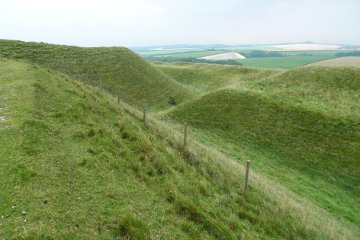
| |
| At this point there are four separate banks, the largest and highest of which is the innermost one. |
Even more impressive is the fact that the banks and ditches surrounding Maiden Castle were commensurate with the area of the place. They are huge! Admittedly the builders were helped by the natural slope, but nevertheless from the top of the innermost bank to the bottom of the ditch in front of it is 40' if it is an inch! Even the fittest naked warrior would be puffing and wheezing by the time he had scrambled up that slope and the defenders at the top could have sent him tumbling down to the bottom with a gentle shove from a stick!
However the people inside were armed with a good deal more than sticks! Excavations at the site have turned up some impressive weaponry - and not just of the poking and slashing kind. It would appear that the people of Maiden Castle relied heavily on projectile weapons, in particular slings. Down by the eastern gate Sir Mortimer Wheeler discovered a pit that had been filled with rounded pebbles, just the right size for a sling, brought all the way from Chesil Bank, six and a half miles away. Someone with loads of time on their hands counted the stones - there were 20,000 of them! That's an awful lot of basketfuls of stone carried up one donkey-load at a time.
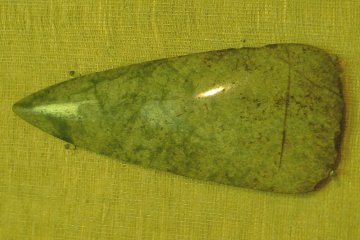
| |
| This jade axe head was brought from the Italian Alps near Mt Viso. |
The first settlement on Maiden Castle hill was back in the Neolithic, but then the site appears to have been abandoned, for there are no Bronze Age remains at all. The great fortifications that we see today were started at the dawn of the Iron Age and five hundred years later must have been reaching their apogee. They were finished just in time to face their greatest test - and they failed.
In AD 43 the Roman legions under Vespasian - the man who was later to destroy Jerusalem and then become Caesar - arrived as part of a great push down into the south-west of England. In this bit of imperial pacification of hostile tribes the records tell us that the Romans fought 30 battles and captured 20 forts - and although Maiden Castle is not specifically mentioned, we know that it was one of those forts.
When Sir Mortimer Wheeler excavated the eastern gateway he discovered a huddle of 52 graves inside it. Most were of young men, many of whom bore signs of severe injuries. One skeleton was discovered with the iron head of a ballista bolt lodged in the spine! In his report Wheeler identified these as the defenders who died when the Romans assaulted Maiden Castle and describes how the bodies were tumbled into their graves to clear the area as the victorious legionaries set up camp.

| |
| The Dorchester Museum is housed in a splendid Victorian building that is itself worth seeing. |
Having seen photographs of this grisly find, I was eager to visit Dorchester Museum to see whether there was any further information. I was somewhat taken aback to be charged £6.50 for the privilege - most county museums in Britain are now free, and even those that do charge are usually much more modest in their demands. I was especially displeased as much of the museum is dedicated to Thomas Hardy, in whom I have no interest whatsoever - but then, I suppose that those attracted to the museum by the great author are similarly displeased to have half the museum dedicated to archaeology!
I was also a little disappointed in the layout of the museum, which smacked more than somewhat of the 1950s, with dusty glass cases housing a vast jumble of objects, not all of which were labelled. Although I disapprove of those museums which have room after room of artistically laid out panels telling you what you are going to see and then a single spotlit object in the final room, Dorchester Museum appeared to verge on the opposite extreme and a little more interpretation would not have gone astray.
It would appear, however, that the curators of the museum have received their training in Egypt, where a single LED in a black echoing chamber is the norm and visitors grope their way around the stygian gloom, stubbing their toes on granite sarcophagii unseen in the darkness. I appreciate that excess light can damage delicate fabrics and fade ancient colours, but I did think that Iron Age pots and Neolithic flints were more or less immune! In many cases the level of light was insufficient for me to read the labels that lay on the shelves beside the objects, which was very frustrating.
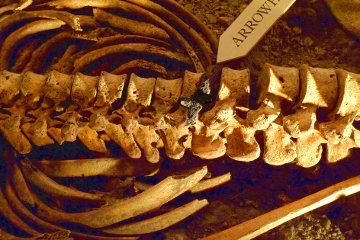
| |
| A close-up picture of the ballista bolt embedded in the spine of a defender of Maiden Castle against the Romans under Vespasian. |
Neverthless, there, in pride of place, was the burial in which I was interested. Two skeletons entwined in death, and a large cardboard pointer drawing attention to the ballista-head (miscalled an arrow head) embedded in the unfortunate man's spine. My Lumix camera was chosen specifically because of its low-light capabilities, but even so it has required a degree of creative work in Photoshop to produce the picture you see opposite.
There were various interesting objects on display in the other galleries of the museum. A rather large chair that was reputed (falsely) to have accommodated Judge Jeffries' posterior during the Bloody Assizes and an iron spike, formerly part of a church-yard railing, on which the heads of his victims were displayed (except that as far as my knowledge of history goes, Jeffries hung his victims, not beheaded them). There was even a splendid Roman mosaic on which you could walk - one of the advertised attractions of the place - but I cannot bring you a picture of it. In order to justify the somewhat extortionate entrance fee the museum was playing host to a Star Wars exhibition and right in the middle of the mosaic was a bloody mannequin with half a face and an outsize laser weapon.
Despite the gripes, I thoroughly enjoyed my visit to the museum and found it informative and interesting - but then, I knew what I was looking for and was already well informed about Maiden Castle and many of the other places whose finds are preserved in the museum. No one should visit Dorchester without spending some time in the Dorchester Museum. Details of admission charges and opening times can be found on the museum web site.
You can see a film about Maiden Castle on our companion NWTV website. Click here for the film.
However Dorchester was not finished with its archaeological surprises. As I walked down the High Street towards the museum I noticed a Tutankhamun Exhibition on the other side of the street and on my way back to where my car was parked I called in. Admission prices were on a similarly ambitious scale and photography inside the exhibition was strictly forbidden, so I excused myself from going in, but I did chat to the lady behind the counter, who turned out to be a Tutankhamun enthusiast who has made the trip to Egypt several times.
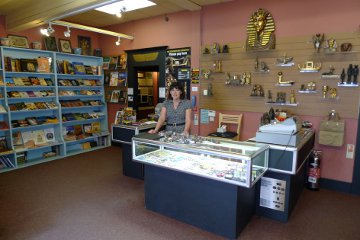
| |
| The Tutankhamun Exhibition is well served by this enthusiastic and knowledgeable lady. I hope they appreciate her! |
The exhibition has been in Dorchester for twenty-five years and consists of a good deal of background information - Dorchester Museum take note - and then a final section in which the famous tomb is recreated as Howard Carter found it. The objects on display are all museum replicas and are produced to a higher standard than the somewhat crude representations found in the Pharaonic Village in Cairo. They even boast that they have used the original materials "wherever possible", a somewhat breathtaking claim given the sheer quantity of gold in Tut's tomb! I presume that "wherever possible" does not include the solid gold of the famous death mask or the innermost coffin.
I was sorry to see that photography was prohibited. Even though I have been to Egypt countless times and have plenty of photographs of the treasures in the Cairo Museum, I would have welcomed the opportunity to photograph the excellent exhibition of the objects in context (and Howard Carter himself supervising the removal of the gold coffin!) If photography were allowed - even if you had to purchase a permit - I would unhesitatingly recommend this exhibition. As it is I merely record the fact of its presence. Further details can be obtained from its website.
Even so, Dorchester was not done with me yet, for I discovered that a little further down the same street there was yet a third exhibition, this time of China's Terracotta Warriors. Again, I didn't go inside - my interest in the Terracotta Warriors is on a par with my interest in Thomas Hardy - but this is something for which I have long campaigned. The world's great museums do not own the treasures they contain: we do! Not only were most of those treasures purchased with our money - public money raised by taxes - but the great objects of art and history belong to the world, not to any nation, still less to any institution.
I long to see the day when we can pop into a little town like Dorchester and feast our eyes on the Treasures of Tutankhamun from Egypt, the Terracotta Warriors from China, the Elgin Marbles from Greece, the Samaria Ivories from Israel, the Mona Lisa from France and the Last Supper from Italy. This, after all, was the original purpose of museums - not to preserve ancient objects but to hold them so that students of art and architecture could learn the elements of good design and great art. Two huge galleries in London's Victoria and Albert Museum are dedicated to plaster casts of work by Benvenuto Cellini! Even snooty Cambridge has a museum of plaster casts of great sculpture, and though the bone-headed morons there deserve kicking, their reproductions could be a most valuable resource if properly advertised and used.
Today, when perfect reproductions can be made without the trauma of pouring plaster or silicone on the fragile and irreplaceable originals, there is simply no excuse. The museums of the world have a positive duty to produce digital copies of their treasures and make them available to the world at minimal cost so that anyone with a computer (and, ideally, a 3D printer!) can benefit from and enjoy the great cultural and artistic achievements of our forebears.
a religious centre A weakness of this theory is that no great sanctuary has been found on the summit of Maiden Castle. There are three possible explanations: the first is that we simply haven't found it yet. The area enclosed by the ramparts has not been fully excavated - in fact, archaeologists have barely scratched the surface, so to speak, and there is plenty of unexplored room for a very large sanctuary indeed.
The second possibility is that the Romans destroyed the sanctuary when they conquered Maiden Castle. This is entirely possible; the Celtic religion was a fairly dark and dreadful form of paganism and descriptions of Celtic sanctuaries - both historical and archaeological - tell of human sacrifices, skull fetishes, and rotting corpses hanging from oak trees. The Romans took an almost Victorian delight in destroying these cult centres and replacing them with "civilised" Roman religion. The fact that they forced the population to abandon Maiden Castle and move to the new settlement of Durnovaria may point in this direction.
However the third possibility is that the sanctuary was nothing more than an open space, perhaps marked out by a few wooden poles. In such a case there would be very little for the archaeologist to find and it would take both extensive and careful excavation to recognise such a sanctuary. Return
tumbled into their graves Further consideration of Wheeler's discovery has led people to question this interpretation. Only a few of the bodies bore signs of injury and all of them were buried with grave goods as well as weapons. The current interpretation is that this was a cemetery for young warriors, some of who may have died in battle, others of natural causes.
Personally, I am reluctant to abandon Wheeler's interpretation. The ballista bolt is undoubtedly Roman and the only time such an injury is likely to have occurred was during the capture of Maiden Castle. The fact that the head was left embedded in the unfortunate man's spine indicates that the burial was fairly hasty, for it was a fairly large chunk of iron and it would surely have been removed if burial had been a leisurely and ceremonious affair.
Nor need we be too disconcerted by the absence of obvious injuries on the majority of the skeletons. There are plenty of ways in which someone can be killed - even with bladed weapons - without leaving marks on the bones. Throats can be cut, vital organs pierced, yet the skeleton remains unmarked. The Romans were not, on the whole, vindictive conquerors. They killed when necessary but then sought to win the hearts and minds of the conquered and allowing the grieving relatives to bury their dead, complete with grave-goods and weapons, was an obvious move - to say nothing of the fact that a buried weapon cannot be used against you! Return
bloody mannequin I wish to assure readers of a scrupulous turn of mind that the adjective is used descriptively (and accurately) and not perjoratively. Return
Terracotta Warriors Looking at the website, it would appear that the museum contains reproduction terracotta warriors such as were offered to us when we visited Xian - in fact, we were taken around the workshop producing them and saw the whole process, from pressing the clay into the moulds to accepting credit cards from enthusiastic tourists. You could purchase anything from 6" high miniatures to full-size replicas and it appears that the owners of Dorchester's attraction have done just that.
This does not make their museum any less valuable, for not everyone can afford the money or time to travel out to Xian. Their website, which was apparently written by chimpanzees (and illegally immigrated ones at that) or, alternatively, the typical product of Britain's disintegrating school system, is here. One day they may realise that an exhibition can "consist of" various things, or it can "comprise" various things, but it cannot "comprise of". Return
© Kendall K. Down 2011





